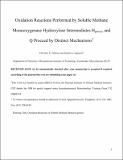| dc.contributor.author | Tinberg, Christine E. | |
| dc.contributor.author | Lippard, Stephen J. | |
| dc.date.accessioned | 2011-12-14T21:36:05Z | |
| dc.date.available | 2011-12-14T21:36:05Z | |
| dc.date.issued | 2010-09 | |
| dc.date.submitted | 2010-07 | |
| dc.identifier.issn | 0006-2960 | |
| dc.identifier.issn | 1520-4995 | |
| dc.identifier.uri | http://hdl.handle.net/1721.1/67687 | |
| dc.description.abstract | Soluble methane monooxygenase is a bacterial enzyme that converts methane to methanol at a carboxylate-bridged diiron center with exquisite control. Because the oxidizing power required for this transformation is demanding, it is not surprising that the enzyme is also capable of hydroxylating and epoxidizing a broad range of hydrocarbon substrates in addition to methane. In this work we took advantage of this promiscuity of the enzyme to gain insight into the mechanisms of action of Hperoxo and Q, two oxidants that are generated sequentially during the reaction of reduced protein with O2. Using double-mixing stopped-flow spectroscopy, we investigated the reactions of the two intermediate species with a panel of substrates of varying C−H bond strength. Three classes of substrates were identified according to the rate-determining step in the reaction. We show for the first time that an inverse trend exists between the rate constant of reaction with Hperoxo and the C−H bond strength of the hydrocarbon examined for those substrates in which C−H bond activation is rate-determining. Deuterium kinetic isotope effects revealed that reactions performed by Q, but probably not Hperoxo, involve extensive quantum mechanical tunneling. This difference sheds light on the observation that Hperoxo is not a sufficiently potent oxidant to hydroxylate methane, whereas Q can perform this reaction in a facile manner. In addition, the reaction of Hperoxo with acetonitrile appears to proceed by a distinct mechanism in which a cyanomethide anionic intermediate is generated, bolstering the argument that Hperoxo is an electrophilic oxidant that operates via two-electron transfer chemistry. | en_US |
| dc.description.sponsorship | National Institute of General Medical Sciences (U.S.) (grant GM032134) | en_US |
| dc.description.sponsorship | National Institutes of Health (U.S.) (Interdepartmental Biotechnology Training Grant T32 GM08334) | en_US |
| dc.language.iso | en_US | |
| dc.publisher | American Chemical Society | en_US |
| dc.relation.isversionof | http://dx.doi.org/10.1021/bi1009375 | en_US |
| dc.rights | Article is made available in accordance with the publisher's policy and may be subject to US copyright law. Please refer to the publisher's site for terms of use. | en_US |
| dc.source | Prof. Lippard via Erja Kajosalo | en_US |
| dc.title | Oxidation Reactions Performed by Soluble Methane Monooxygenase Hydroxylase Intermediates H[subscript peroxo] and Q Proceed by Distinct Mechanisms | en_US |
| dc.title.alternative | Oxidation Reactions Performed by Soluble Methane Monooxygenase Hydroxylase Intermediates Hperoxo and Q Proceed by Distinct Mechanisms | en_US |
| dc.type | Article | en_US |
| dc.identifier.citation | Tinberg, Christine E., and Stephen J. Lippard. “Oxidation Reactions Performed by Soluble Methane Monooxygenase Hydroxylase Intermediates H[subscript peroxo] and Q Proceed by Distinct Mechanisms.” Biochemistry 49.36 (2010): 7902-7912. | en_US |
| dc.contributor.department | Massachusetts Institute of Technology. Department of Chemistry | en_US |
| dc.contributor.approver | Lippard, Stephen J. | |
| dc.contributor.mitauthor | Tinberg, Christine E. | |
| dc.contributor.mitauthor | Lippard, Stephen J. | |
| dc.relation.journal | Biochemistry | en_US |
| dc.eprint.version | Author's final manuscript | en_US |
| dc.type.uri | http://purl.org/eprint/type/JournalArticle | en_US |
| eprint.status | http://purl.org/eprint/status/PeerReviewed | en_US |
| dspace.orderedauthors | Tinberg, Christine E.; Lippard, Stephen J. | en |
| dc.identifier.orcid | https://orcid.org/0000-0002-2693-4982 | |
| mit.license | PUBLISHER_POLICY | en_US |
| mit.metadata.status | Complete | |
